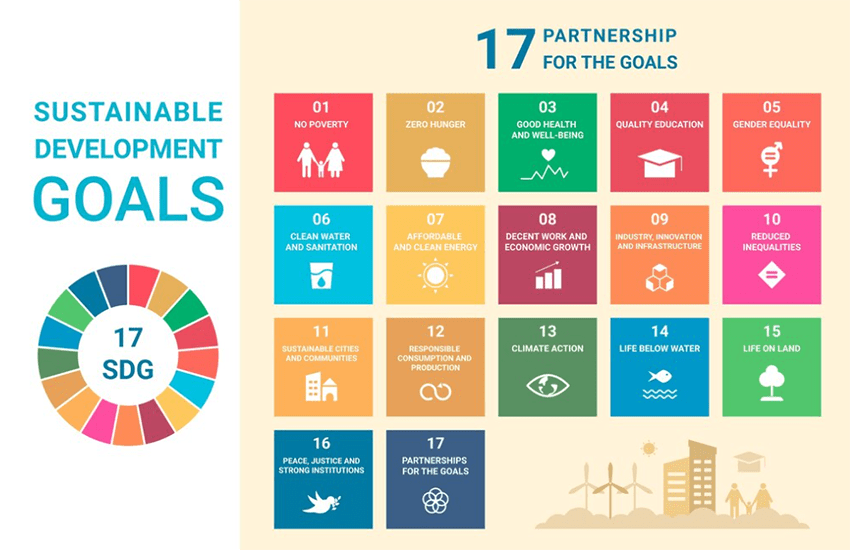Organisational collaboration at all levels, whether local, state, federal, or international, will act to lift the heavy Sustainable Development Goals (SDGs). This is not a bad thing. It’s about working together, with fixed purpose and intent, unified in motive, to create a better world for all. In fact, there are tonnes of benefits of collaboration. Furthermore, not only will the organisations involved benefit from these collaborations, but all of humanity will.
“Teamwork is the ability to work together toward a common vision. The ability to direct individual accomplishments toward organisational objectives. It is the fuel that allows common people to attain uncommon results.”
Andrew Carnegie
Did you know that in physics, there is a principle called load sharing? This principle means that a very heavy load can be lightened if there is more to carry it. Forces that are spread out over a length, area, or volume are called distributed loads. I remember this from a time long ago, in a very near galaxy, when I nearly went abseiling. During the experience, we were taught that loads can be lightened by repassing the same rope through the carabiners and the harness.
If you consider the SDGs as the load, how are we going to lift them? Individually, we can do a little, such as changing our lifestyle habits and consumption. However, large organisations have the power to really pull the weight. Furthermore, as organisations collaborate, they will be able to share the load making it lighter. Think of all the benefits of collaboration that there will be when this happens.
Chelsea’s story*
Chelsea glared at her financial statement. It showed a huge financial loss. She had wanted to source her textiles from a local Indigenous manufacturer partnership, which was also a small partnership, like hers. However, the product was more expensive, though it was sustainably sourced and left a reasonably smaller carbon footprint than having textiles imported from overseas.
Picking up her phone, she dialled the number of her partner. Maria answered on the third ring. “Hi, Chelsea.”
“Hello, Maria. I don’t have good news. We are down by several thousand dollars. There is an over-abundance of stock in the warehouse that hasn’t moved, and we have to pay our suppliers.”
“Give me some time to make a couple of phone calls, Chelsea. I’ll get back to you later today.”
To be continued…
*Chelsea’s story is a work of fiction, including characters, circumstances, and location.

Source: Freepik.
What are the benefits of Organisational Collaboration?
What Is Collaboration?
Collaboration is when individuals, groups, organisations, basically anyone or anything, team up to work together in order to attain a mutual goal. Collaboration works best when there are benefits of collaboration for all parties. However, the benefits need not necessarily be fiscal. The ultimate benefit of organisational collaboration will be a more sustainable world. That’s in the far-off future. People want results now. Organisations need money to run. The benefits of collaboration need to be in real time.
Benefits Of Organisational Collaboration And Advancing The SDGs
When organisations collaborate to advance the SDGs, it has several perks. They can team up, combining their skills and resources, which makes achieving the SDGs easier and more effective. Indeed, working together sparks innovation, leading to creative solutions for challenges like poverty and climate change. Collaboration also means sharing knowledge and letting organisations learn from each other’s successes and failures. Plus, it boosts their ability to influence policies and gain support for the SDGs on a larger scale. In a nutshell, collaborating speeds up progress, maximises impact, and unites the global effort to achieve the SDGs.
Why is it essential that we focus on Organisational Collaboration and its benefits?
Organisational collaboration is important for sustainability because it allows them to work together, share ideas, and resources. By collaborating, organisations can learn from each other, improve their eco-friendly practices, and have a stronger influence on policies. As a result, this teamwork creates a shared responsibility and leads to a more sustainable future.
In fact, you can get involved in promoting sustainability by joining local environmental groups, volunteering, supporting eco-friendly businesses, and spreading awareness about environmental issues. Furthermore, simple actions can make a big difference in creating a more sustainable future. This is how you, as an individual, can begin to collaborate with others and reap in the eventual benefits of a brighter, more sustainable future world for us all.
moving forward
Chelsea’s story
…continued.
The phone rang on Chelsea’s desk as she was walking away. She raced over and answered. “Hi, Maria,” she said, breathless.
“Hey, Chelsea. Good news. I made contact with a friend of a friend, who knows somebody who works at the top of The Company. They are interested in our clothes designs with the fabrics we’ve been getting. If we put their brand on our label, they will help us out financially.”
“They want to buy us out?”
“No, Chelsea. They want us to keep our brand, label, and company. All they want to do is put their name next to ours.”
“Why would they help us out, Maria?”
“They have somewhat of a negative reputation when it comes to sustainability. What they’ve been doing is looking for sustainable initiatives to financially support instead of greenwashing and carbon credits. We boost their sustainability game, they help us out of this. What do you say?”
“Yes, Maria. Let’s do it.”

Source: Freepik.
achieving the United Nations Sustainable Development Goals (SDGs) and how they link to The benefits of Organisational collaboration
“The 2030 Agenda for Sustainable Development, adopted by all United Nations Member States in 2015, provides a shared blueprint for peace and prosperity for people and the planet, now and into the future. At its heart are the 17 Sustainable Development Goals (SDGs), which are an urgent call for action by all countries – developed and developing – in a global partnership.”
United Nations
“Strengthen the means of implementation and revitalise the Global Partnership for Sustainable Development.” This is SDG 17. Without collaboration and partnerships between individuals, governments, NGO’s, companies, and all sorts of other organisations, we aren’t going to make a single goal or build the future for humanity that everyone deserves. The single most important benefit of collaboration between any individual or organisation is a thrivable life.
A Thrivable Framework
Systemic Holistic Model
THRIVE stands for The Holistic Regenerative Innovative Value Entity and forms the basis for the Framework. In fact, the Framework itself is a transdisciplinary holistic model so that outcomes of actions can be known before they occur. Furthermore, this Framework is underpinned by 12 Foundational Focus Factors (FFFs). Indeed, if the SDGs are the goals for sustainability, the Framework is the path.
Sustainability is not just about surviving but thriving. The 12 FFFs, along with the THRIVE platform, which uses backcasting to solve problems, is about leading the way from survivability to ‘Thrivability‘.
Complex, Wicked Problems And Benefits of Collaboration
Complex, wicked problems is one of the FFFs of the Framework. Indeed, these are challenging issues in the realms of society, culture, politics, or economics, characterised by its complexity and the uncertainty of finding a solution. Moreover, these problems arise from unpredictable and ambiguous situations. Often, the solutions may cause problems in other areas. Hence their complexity.
Some of the benefits of collaborations tie into solving complex, wicked problems. Indeed, when working as an individual organisation, what one does to solve a problem may impact another, humanity, or the environment negatively. When more organisations collaborate, they are able to share real time data on impacts and not cause further issues when implementing solutions. As a result, working together, they can work through these issues finding win-win solutions for all.
Systems Thinking And Benefits of Collaboration
Systems thinking, another FFF, is big-picture thinking. It moves beyond step-by-step problem-solving thinking, instead of viewing a situation in a holistic matter. Once again, the benefits of collaboration are myriad when using integral thinking. In fact, what one organisation may not see, another can. Furthermore, using integral thinking, they can view the circumstance with a broader view and instead of depending on a traditional, linear problem-solving mind-set, they can develop innovative solutions from an expanded viewpoint.
Materiality And Benefits of Collaboration
Materiality is the FFF about what is significant and relevant. When it comes to reporting, organizations often only focus on financial materiality. To clarify, a $1000 loss to a multinational organisation may mean peanuts, but the same loss to a sole trader is caviar. In fact, sustainability materiality goes beyond financial materiality. Furthermore, it guides sustainability as a holistic picture of how organisations, stakeholders and finance have an impact in the non-financial real world.
When it comes to materiality, there is a tonne of benefits of organisational collaboration. Remember when we talked about sharing the load? When a larger and smaller organisation are collaborating, the larger company is able to carry a burden easier than the smaller company. In exchange for this collaboration, the smaller company may offer innovative ideas and solutions towards sustainability.
Entity Model
The FFFs of the Entity Model aim to navigate what entities can do. In fact, an entity can be anything from a small single-celled organism to the entire cosmos. Furthermore, these models shape the boundaries that outline their limits. THRIVE’s logo, a ciambella chart, outlines two important boundaries for humanity to adhere to. These boundaries are – a social floor, denoting the minimum for an entity’s survival; and an environmental ceiling, where too many resources are taken from the environment.
When organisations collaborate, pooling their various resources and extending their reach, solutions present themselves. Two companies working together, using their data, will better be able to understand the impact they have on the environment and take action to remain beneath the environmental ceiling. The same goes for the social floor. When organisations collaborate amongst themselves for the benefit of society, they are better able to ensure that the society around them has what they need.
However, ultimately, it is about mindset, whether that of the individual, individuals of the company, or the company itself as an entity. The entity needs to be geared from within to understand that everyone, including the organisation, is better off when everybody is flourishing.
Collaboration For Transformation
As you can see there are numerous benefits of collaboration. If you want to collaborate with us, you can visit our homepage, sign up for our newsletter, listen to our podcast, watch our videos on our YouTube channel, read our blogs, or interact with experts during our webinars. Thank you for reading this article and continue thriving!























